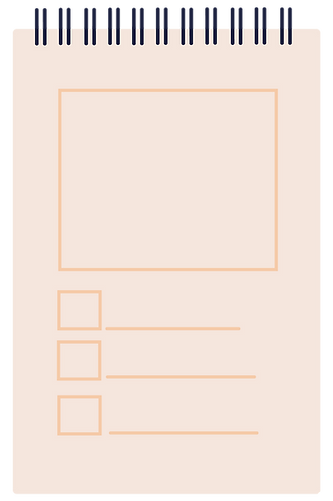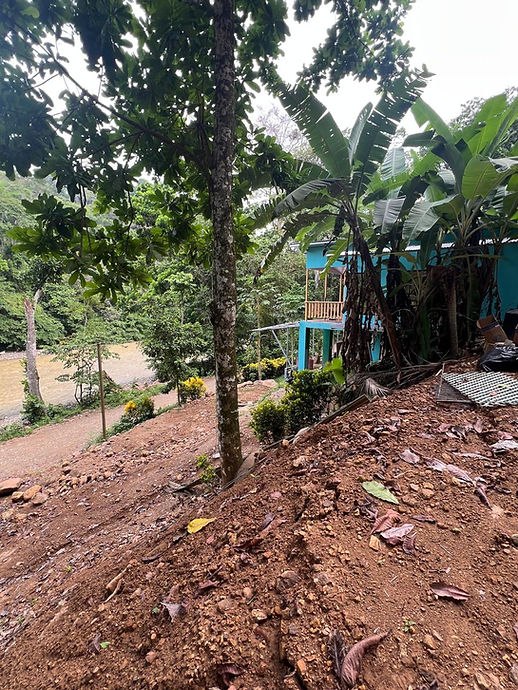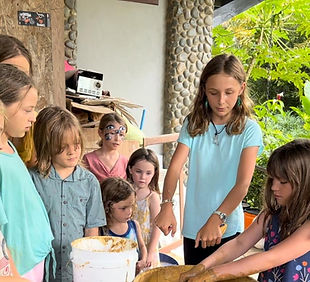
" How much does
the ceramic class cost? "
Vicky and Rosa—lifelong locals. They either walk their dogs… or just walk themselves, like the dogs got the day off. 😂 They were the first ones to ask me,

The real power is the local people.
Costa Rica has so much creative potential—but very little access to
free, high-quality art education.
Most kids grow up without the opportunity to explore ceramics, design, or digital tools.
I want to change that.
We envision Cherepos Artes as a bridge
a space for
Local elders, students, working / retired adults .

Large falling tree, three chainsaws,
about ten strong local Ticos—return?
Homemade banana bread. Thank you, amigos!
Bring your loved one or come join the ceramic studio.

Free Art Education for Locals
I've taught and observed ceramics across Costa Rica since 2021. Every time there's a cost—even a small one—the people who need it most disappear.
But when the class is free?
They come. They stay. They thrive.
That’s why we created a
work exchange model!
You help us process the local clay, take part in the class for free,
use the clay you helped prepare
The only extra costs? Materials like glazes or tools—things we’ll handle as accessibly as possible.
This is about redefining value—where effort, community, and earth are the currency, not exclusion.


Pandapanther Ceramics
Kids Clay - Free For Local Kids 2023
Material firing fees donated by Sara.O.S 🙏

"Free Wheel Trial"
Domi Art Fest 2021, 22 @ Fuego
At the heart of the Cherepos Artes project is one simple truth
abundance is already here.
What I found in this location—facing the Barú River, backed by a hill rich with natural clay, and held by the quiet strength of the local community—is all the raw material we need to build something transformative.

The Studio Map

Cherepos Clay
One rainy day, we were walking the property when we noticed something magical—super sticky mud! My kids kept slipping and falling, their rain boots stuck so deep I had to pull them out by hand. That sticky, yellowish clay instantly reminded me of the gentsuchi I touched in Mashiko, Japan. No smell, extra plastic, just beautiful workable clay—right here on our land.
As a lifelong clay lover, I knew I had to test it. During the school break in January, I had the kids help me process and throw the clay. The results were incredible. It works at cone 6 and even passed the final challenge: surviving direct fire in a smudge basin where we burned charcoal and resins like copal. The Cherepos said, "No problem!"
This clay works beautifully at low to mid-fire temperatures and holds up in traditional fire use. All my research and tests are ongoing—you can follow it all here: instagram.com/pandapantherceramics.
We’re still improving shrinkage and experimenting with temper. This isn’t just clay—it’s a creative goldmine waiting to be shaped.
Fundraising Projects
Project Noborigama


One of the foundational dreams of Cherepos Artes is the creation of a Noborigama kiln —a traditional Japanese climbing kiln, reimagined for Costa Rica’s landscape.
Inspired by the Noborigamas I saw in Mashiko, Japan, we plan to carve our kiln directly into the hillside, using the natural slope to its full advantage. The geography here, steep like a double black diamond hill, offers the perfect canvas for this type of kiln, maximizing natural airflow and heat dynamics.
Key features of the Cherepos Noborigama
Built into the hillside with a structure covered by 1–2 meters of soil, reinforced naturally with stone or brick
Multiple chambers possible over time, starting with a firing chamber, ceramics chamber, side entry, and chimney
Overhang/roof design will depend on the firing season, with additional rain protection if needed for rainy-season firings
Clay excavated from the site will be used for ceramics, giving the earth itself a second life as art
Every scoop dug is intentional, shaping both the kiln and the future creations it will fire
Educational Programs
Digital Arts




Community Digital Art Classes
Led by talented teens and guided by experienced mentors, these classes focus on real-world tools like Adobe Creative Cloud, Sora, and iPad apps. Students explore animation and design, balancing creative expression with mindful screen use.
Drawing Session: From Imagination to Paper
When I visited Arthouse Atenas, I saw how vital traditional drawing classes are for our region. Growing up in Japan, quick 5-minute sketches trained me to confidently draw from imagination. At Cherepos Artes, every student begins with pencil and paper—no Wi-Fi, no apps—warming up creativity before diving into digital or ceramic projects.

ArtHouse Atenas 2023
Community Workshops
Another vivid memory from my school days in Japan: we had hands-on home-making classes like cooking, sewing, and carpentry. I still remember the excitement of crafting animal-shaped puzzles on a band saw! Today, skills like sewing are rare—but they unlock endless creative fun. At Cherepos Artes, students can explore practical crafts, medicinal plants, and local natural materials, plus sushi-making and Japanese cooking workshops. Classes are free with work exchange; only materials may have a small cost.

This space is open to anyone who wants to offer free classes
How You Can Support
Clay Is Our Currency. Time Is Our Gratitude.
Work exchange model
Help process the clay
Join classes for free
Use the clay you helped prepare

Adopt a Wheel
$2,000 = 1 new wheel (includes shipping & setup)
You get: 1 year of sponsor-class access, private wheel lessons, your name on a community wheel

Business & Corporate Sponsorship
Return: sponsor recognition, private / team classes,
tax documentation

Computer Room Sponsorship
Help us equip our digital media room with:
Adobe Creative Cloud licenses
New computers and iPads
Projector system
Cherepos Artes – Milestones
FALL 2025
Clay processing zone, parking facility completed.
Legal structure complete (mother corporation + foundation).
Co-op eligible for tax-deductible donations.
Local classes, work-exchange program officially begins.
Dec 2025
Visitor Program Start. Start using cherepos aged clay.
March 2026
Wrokshop series, Bring ceramic wizards from overseas.
About Cherepos
The name Cherepos isn’t just a name—it’s a story shouted into the wind.

Long ago, during the rainy season, the Barú River would rage with such force that crossing it was an act of bravery. The local Ticos—strong, relentless workers—would make the crossing each morning to get to the other side for work. One day, during a particularly wild flood, someone screamed out:
“¡Mirá esos Cherepos!”
“Look at those Cherepos!”
A nickname was born—half awe, half admiration—for the people who could laugh, cross, and keep going no matter how hard life swelled around them.
Since the 1960s, the Cherepo family has lived and thrived here. They are known for being crafty, resourceful, and deeply creative. In the 1980s, they were even known as Grupo de los Cherepos, a musical family group that brought rhythm and soul to the region.
Today, many family members work in construction—still creating with their hands, still shaping the world around them. Cherepos Artes honors that legacy by offering a new outlet for their creativity: ceramics, digital design, and shared cultural knowledge.

Foundation Members
My deepest gratitude goes to the friends who helped me get here—and who continue to walk this path with me. This project stands on your shoulders.

Gwendy Obando
Legal / government correspondence
Meet Gwendy Obando—the powerhouse behind True Law Firm and the magic-maker at Awa Natural. If handling all the legal intricacies wasn't impressive enough, Gwendy has also transformed skin everywhere (including mine!) through her personal skincare endeavor, Awa Natural. Seriously, it's like she sprinkles fairy dust into every jar.
But wait, there's more: she's running two successful businesses, raising two amazing kids, and cherishing one adorable grandchild. When does she sleep? Honestly, your guess is as good as mine. All I know is that in the two years I've known her, she hasn't missed a beat—or a single deadline!
Gwendy will also be handling all government correspondence and managing all legal matters related to the foundation, ensuring smooth sailing on every front. Whether you need sharp legal guidance or skin that glows like you've slept eight hours (even if you haven’t), Gwendy’s your go-to. Friend, lawyer, skincare wizard—she’s got you covered!
Alex Marvin Montoya
Site Development, Build, Local correspondence
Alex Marvin Montoya, my landlord and head of Cherepos Construction, embodies a ninja-level dedication to his craft and community. When I met Alex about a year ago, I instantly found my dream Tico apartment just minutes from my project. Despite our amusing language barrier—my Spanish is limited, and Alex playfully pretends not to speak English—we communicate through shared smiles and gestures. From seeing how tightly knit the community is, I know their routine: wake up at 5 am, perfectly timed meals prepared by Alex’s hardworking mama, and lights out by 9 pm. Alex, a third-generation Cherepos, carries forward the legacy of his father, Marvin, alongside his beautiful and clever wife Nina and their son Mateo, the fourth generation. Their charming mountain community, established in the 1960s, reminds me warmly of Totoro’s Japan—making me feel like their long-lost cousin, Cherepas, from Japan. ¡Gracias Familia Cherepos!



Cecile Petrelluzzi
Ceramics Adviser / Local correspondence
Cecile Petrelluzzi and I first connected at the 2021 Domi Art Fest when she asked, “Do you mix your own glaze?” (the ceramist’s version of “What’s your sign?”). Ever since, she's been my mentor, glaze guru, and occasional sanity checker. Now I'm excitedly bringing her into my new foundation. Originally from St. Martin, Cecile’s extensive knowledge spans ceramics, local plant wisdom, environmental studies, and even the occasional oracle reading—all top-notch. Her innovative glaze studies using local ash and clay will be a significant addition to our studio, promoting sustainable glaze practices. She consistently satisfies my endless curiosity and will be coaching me as well as handling local correspondence for the foundation.
Closing Letter from Naomi
I still remember the moment I saw it a hand-carved Chorotega pot in a Dominical souvenir shop. Priced at just $25, it broke my heart. Months of tradition, labor, and skill sat beside novelty mugs like it meant nothing. But for the maker, it wasn’t about the money, it was about joy, connection, and legacy.
That moment stayed with me. Though I never visited the Chorotega communities, I’ve studied their methods and felt a deep connection. I see that same spirit in the Cherepos, abundance, rhythm, and strength.
I came to build a small studio. Instead, I found clean clay, pristine water, and something far greater: a family legacy and a creative force ready to rise.
Cherepos Artes is my way of giving back—a space where local kids can grow and create, and visitors can witness true Costa Rican artistry. A place where art, education, and tradition walk hand-in-hand.
With deep gratitude to the entire Montoya family.
To Jack and France, for listening.
To Chris, for early consulting—wishing you a smooth and full recovery.
To Jimmy, whose trust—and three beautiful daughters—made it real.
To my own children, Kinoa and Denali, for their quiet support, understanding, and everything they do behind the scenes.
And to their father, Jonathan, for supporting us from NYC’s animation world to this Costa Rican ceramics journey.
— Naomi Nishimura
Founder, Cherepos Artes
(@pandapantherceramics)

This project was inspired by Olyvia, whose dream was to create a nurturing space full of art, nature, and love. She hoped to one day have children of her own and raise them in a place like this
—surrounded by creativity, community, and jungle light.
We lost her in this beautiful land in 2023, but her spirit lives on in every part of this project.
Cherepos Artes carries her vision forward—offering a space where others can grow, express themselves, and feel held by the land and each other.
Her dream planted the seed. Now we build the roots.
http://arbolgeneroso.com/








